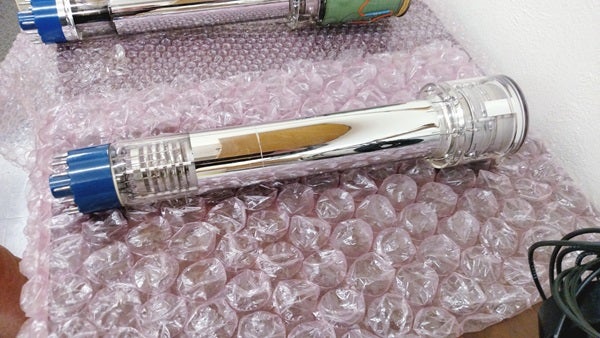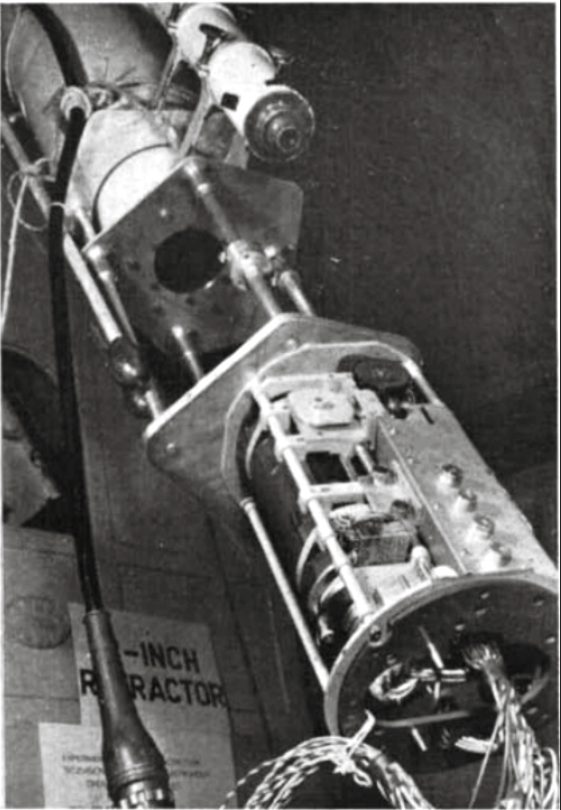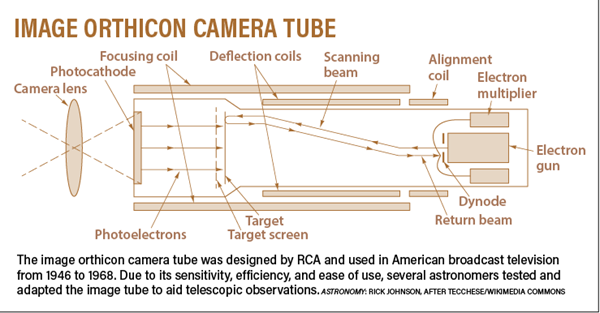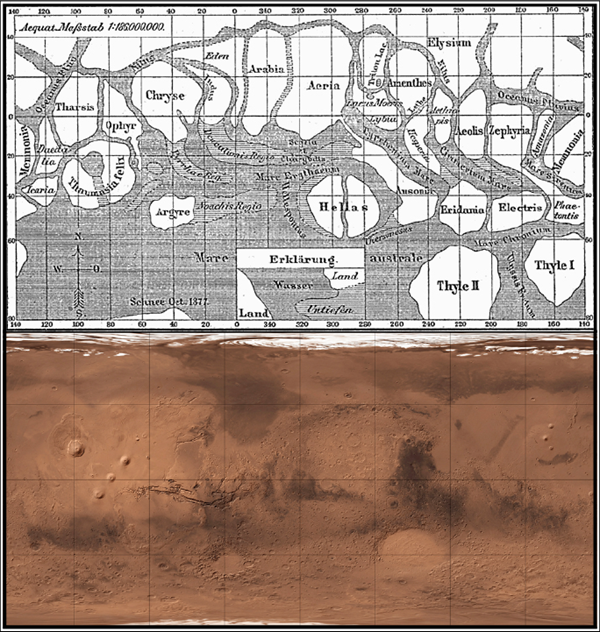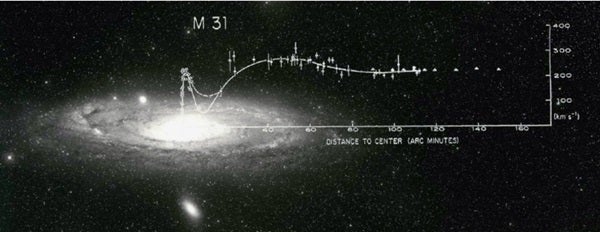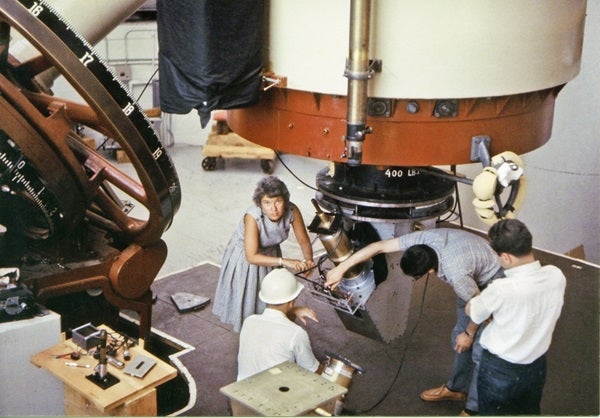American newspapers printed articles detailing the new reaches of space that television would make observable. A New York Times article anticipated “Mars and its ‘canals’ projected as a disk a foot in diameter, the frontiers of the universe pushed out several hundred million light-years, stellar distances measured with an unheard-of accuracy, new revelations of the structure of the great nebula in which we live and we call the Milky Way — the vistas opened are endless.”
Though electronic imaging garnered considerable enthusiasm and had great potential to aid telescopic observations, astronomers dawdled in adopting the technology. In 1964, the National Academy of Sciences published a report noting that “only a few results not attainable by photography had been achieved.” By 1973, they reported that, despite recent advances, astronomers were still a long way from producing a suitable electronic imaging device, and the goal for the next stage of astronomical detectors was still to realize the potential of electronics.
The old ways
Early astronomers had no other option than to sketch what they saw, drawing only what their eyes could detect. But in the late 19th century, photographic emulsions revolutionized astronomy. Photography not only provided a permanent record that was independent of an astronomer’s artistic talent, but also allowed astronomers to take extended exposures and record much fainter objects. But because photographic emulsions were not linear (i.e., the number of photons that struck a grain of emulsion was not directly proportional to how dark that emulsion became), astronomers had to calibrate each photograph.
In 1910, scientists first exploited photoelectric principles, which showed how photons of light could be converted into electrons to measure stellar brightness. Because photoelectric devices did not require calibration, the accuracy of this method far exceeded that of photographic methods. The disadvantage, however, was that only one star’s brightness could be measured at a time, whereas a single photograph could record hundreds of stellar magnitudes simultaneously. To overcome this shortcoming, astronomers began to experiment with electronic imaging devices, generally called image tubes.
Electronic cameras
In 1934, French astronomer André Lallemand began developing his caméra électronique. With this electronic camera, Lallemand converted the light coming through a telescope into electrons, which could be recorded on an electron-sensitive photographic emulsion.
The main weakness of Lallemand’s camera was its complicated operation. After each exposure, the astronomer had to break a sealed glass vial, called an ampoule, to recover the photographic plate. This process destroyed the vacuum inside, requiring the astronomer to commit a day’s labor to prepare the next exposure. Formerly routine observing nights were transformed into complex science experiments, which dissuaded many astronomers from using the device. Still, Lick Observatory astronomers used the Lallemand camera into the 1960s, which helped them collect some of the earliest evidence of active galactic nuclei at the center of Seyfert galaxies.
In 1951, astronomer B.V. Somes-Charlton, in collaboration with Cambridge Observatory in England, observed the Moon’s surface with a commercially available RCA image orthicon camera. Somes-Charlton produced images by attaching the camera tube to the back end of a telescope and sending the video signal output from the image orthicon tube to a television receiver, which produced an image on the television screen. He then photographed the screen using a film camera. When Somes-Charlton compared direct photographs to television-aided observations, he noted the television images had higher contrast. Plus, because the image orthicon tube amplified the light coming from the Moon, the observations took less time. This shortened exposure time decreased some of the blurring effects of Earth’s atmosphere, which astronomers call seeing, resulting in a clearer image. Additionally, Somes-Charlton performed quantitative tests and determined television was superior in sensitivity, resolution, and efficiency.
Somes-Charlton’s early experimental work gave researchers further confidence that electronic imaging could benefit astronomical observations in limited applications. The promising results of these initial tests encouraged astronomers of the potential of the underlying technology, but because most researchers did not work with objects as bright as the Moon, the equipment was not considered employable as an off-the-shelf product. Most astronomers needed a modified system to account for the dim objects they hoped to study.
Bolstering brightness
By the 1950s, astronomers began to seriously investigate possible methods of electronically amplifying the light from a faint object. Numerous efforts — each with different resources, design philosophies, and audiences — focused on developing a system that could amplify and record two-dimensional signals. The devices they proposed ranged widely in feasibility and usability.
The Carnegie Image Tube Committee (CITC), a multi-institution project, was the highest-funded endeavor to develop an image tube that could aid and advance ground-based astronomical observations. Carnegie Institution President Vannevar Bush — who during World War II led nearly all of the American civilian-military research and development efforts from the U.S. Office of Scientific Research and Development — established the CITC to bring together astronomers, physicists, and engineers who could develop such an image tube.
Carnegie’s Department of Terrestrial Magnetism coordinated the CITC, but the project also included members and collaborators from observatories and laboratories across the U.S. and England. The initial goal of the CITC was to explore the possibility that an image tube could supplant or supplement photographic methods, thereby increasing the range of telescopes. The committee hoped their efforts would lead to the development of a manufacturable device with enough sensitivity to light to be beneficial for astronomers engaged in most research programs and whose operation was simple enough that any astronomer at any observatory could use it. During its first decade of operation, the CITC worked with industrial and military laboratories, private and public observatories, and individual astronomers to develop an image tube they could market to observers.
Though U.S. astronomers wished to make further improvements to the device, they quickly grew impatient with what they saw as a lack of productive development from the Carnegie group. By 1964, after a 10-year period of research and development, the Carnegie committee felt they needed to release an image tube for astronomical research. Once released, their tube did receive some modest use, helping astronomers acquire groundbreaking scientific results. But many astronomers never fully adopted the image tube or the technology.
By the 1970s, several decades after Henroteau proposed using electronic imaging devices in astronomy, astronomers from the world’s largest observatories had successfully applied image tubes in a limited capacity. Astronomer William Livingston calculated that during the final quarter of 1972, 26 percent of the observing time on the Steward Observatory 2.25-meter telescope and 45 percent of the observing time on the Kitt Peak National Observatory 2.1-meter telescope were assigned for image tube-aided observations. Though designed to aid modest-sized telescopes, astronomers preferred to use the Carnegie-produced tubes on the largest available telescopes. This was particularly important for those interested in investigating new areas of research that such equipment opened up, such as the study of the physical properties of distant, dim galaxies.
Though Rubin’s research exemplified the potential of image tubes, change was looming; solid-state devices would sweep in and replace image tubes and direct photography in the 1980s. In 1984, Rubin and Ford traveled to Palomar Mountain to obtain spectra of a large spiral galaxy with a spectrograph attached to the Hale Telescope. What made this observing run significant was that the spectrograph was not attached to an image tube, but rather, for the first time, to a solid-state detector. This new charge-coupled device, or CCD, eventually became ubiquitous in most imaging devices, including the cameras on the Hubble Space Telescope. For astronomers, adopting the new technology meant that they no longer needed to carry photographic plates home with them after observing runs, but instead hauled reels of computer tape that could be rapidly analyzed with coded programs.
Rubin’s 1984 observing run at Palomar signaled the beginning of the end of astronomers’ use of image tubes. And although the astronomical community failed to fully adopt image tubes, the ability to see brighter objects and measure them more precisely greatly benefited those hoping to look further into the cosmos to observe fainter objects. Despite the usefulness of electronic image tubes, this oft-forgotten relic of astronomical history highlighted astronomers’ — and humans’ — occasional reluctance to adopting new ways of practicing their art.

